Mushroom farm composting & growing confined spaces
Confined spaces on mushroom farm composting and growing operations can be dangerous. Employers and workers must understand the hazards and know how to work with them before entering the confined space.
The hazards
Below, you'll find general information to help you assess the hazards of confined spaces on mushroom farm composting and growing operations. Please note: there may be confined spaces on your farm not listed here.
Normally, storing grain, feed, or other materials in bins does not produce toxic gases. However, if the moisture content of the material is too high, the material can ferment and toxic gases can build up and replace oxygen in the air. Before entering bins you must also consider any previous use of pesticides or fumigants, and possibly mould.
Bin contents may not flow smoothly and can form bridges or shoulders that are an engulfment hazard. Workers may also be struck by fragments of bridges and hang-ups.
To reduce the risk, modify the cone of a hopper-bottomed bin by using bolted rather than welded joints. This will allow you to remove individual panels so auger cleaning or repair work can be safely performed from outside the hopper.
| Hazards | Hazardous work |
|
|
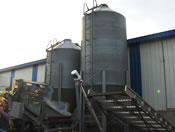
Material storage bins
Wastewater from the mushroom farm composting process (also known as brown water) is collected and stored for reuse, in cisterns, tanks, and sumps. Organic matter in the water (or settled on the bottom) can ferment, producing highly toxic gases that can quickly cause death when inhaled at high concentrations.
To help reduce the risk, install agitators in the tanks or cisterns to keep liquid material aerated. In addition, choose (or retrofit) equipment so you don't have to enter the cistern or tank to complete maintenance and repairs. For example, use agitators that can be removed and repaired outside the cistern or tank.
Workers may also be at risk of drowning if they fall into cisterns or tanks.
| Hazards | Hazardous work |
|
|
 |
 |
 |
 |
| Brown-water cisterns |
Brown-water tank feeding a compost pond |
||
When damp materials like forage plants, compost, or damp feed are stored in a bunker they can ferment and produce hazardous gases. As they ferment, oxygen is used and depleted from the atmosphere. Vehicles, such as front-end loaders, can produce other hazardous gases as they enter and leave the bunker. These gases may accumulate at the surface of the material and collect at the base of the bunker — especially if the bunker is below ground level.
Above-ground, open-front bunkers are not normally considered confined spaces as long as workers and equipment can be easily moved in and out. However, if bunker contents block the entrance, they may create a confined space. Pit or subsurface bunkers are also considered confined spaces.
| Hazards | Hazardous work |
|
|
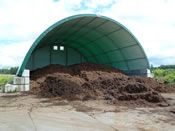
Above-ground bunker
Mushroom compost is created by fermenting straw with a mixture of water (usually brown water), gypsum, and chicken manure. As the compost ferments, very toxic gases can be released. These gases can accumulate at the top or bottom of barns, pits, ponds, and tanks.
Ammonia and methane gas are lighter than air and will accumulate at the top. Hydrogen sulfide is heavier and tends to sink to the bottom of structures. It can also accumulate in drainage systems, such as ditches and trenches, that lead to sumps. As these gases build up, they can replace oxygen in the air.
Workers can also accidentally fall into pits or ponds, break through a crust on the surface, become engulfed, and drown.
To reduce the risk, choose equipment that does not require you to enter it for repair or maintenance, such as a removable agitator. Install agitators in pits and ponds to keep liquid composting material aerated and prevent excess gas from being generated. Install fences around pits and ponds to prevent unauthorized entry.
| Hazards | Hazardous work |
|
|
 |
 |
 |
| Above-ground mushroom farm composting barn |
Composting pond | Composting tank |
Specialized trucks transport compost from manufacturers to mushroom farmers. These trucks are top-loaded at the composting facility and unloaded using a movable bed system from the bottom rear of the truck. Conveyors transport fresh compost from the truck to the growing operation.
Fresh mushroom compost can release toxic gases. Ammonia is lighter than air, but the heavier hydrogen sulfide will sink to the bottom of the truck bed. Bacteria and fungi may also be released into the air as the compost is disturbed.
To reduce the risk, design a pole-mounted pusher so workers can move the remaining compost without entering the truck bed. Install a wash system in the truck bed to help clear compost.
| Hazards | Hazardous work |
|
|
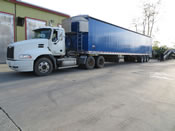 |
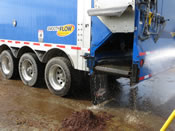 |
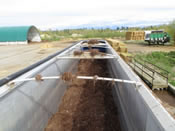 |
| Compost transport truck | Compost transport truck discharge |
Compost transport truck bed |
Conveyors transport solid material from a container to a vehicle or from one location to another. Enclosed conveyors are considered confined spaces.
Depending on the material being transported, toxic gases can build up in the conveyor system. Fermenting material, such as compost, can emit toxic gases that can quickly cause death when inhaled at high concentrations.
Workers may be at risk of injury or death if they get caught in the conveyor or if mechanical equipment is not properly locked out.
To help reduce the risk, choose (or retrofit) equipment so workers are not required to enter the conveyor system.
| Hazards | Hazardous work |
|
|
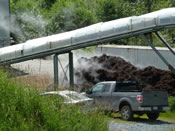
Covered conveyor system
If there is not enough ventilation, crawl spaces or cellars may contain a toxic or low-oxygen atmosphere. The combination of metal and moisture can deplete oxygen because oxygen is used as metal rusts. Other toxic gases may also accumulate, depending on the use of the building above the crawl space or material being stored in the crawl space.
| Hazards | Hazardous work |
|
|
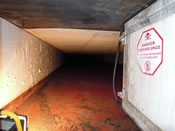
Pasteurization tunnel (crawl space)
Pumps are used to transport water from storage cisterns, tanks, or sumps to composting fields or barns. As organic matter in the water ferments it produces highly toxic gases that can quickly cause death when inhaled at high concentrations.
To reduce the risk, install a ventilation exhaust fan system that can be operated before and while workers are inside. Retrofit pumps and valves that require routine maintenance so they are located near the entrance to the station or shed and workers don't have to climb down to service them.
| Hazards | Hazardous work |
|
|
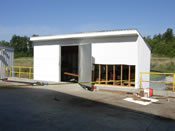 |
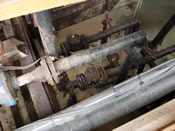 |
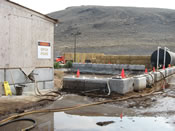 |
| Pump shed | Piping inside a pump shed |
Pump shed and composting pond |
Brown water is collected and stored in cisterns, tanks, and sumps for reuse. Pumps are used to transport water from sumps to composting fields or barns. As organic matter in the water ferments it produces highly toxic gases that can quickly cause death when inhaled at high concentrations.
Workers may also be at risk of drowning if they fall into sumps.
To reduce the risk, choose (or retrofit) equipment, such as pumps, so workers don't have to enter the space to complete repairs or maintenance.
| Hazards | Hazardous work |
|
|
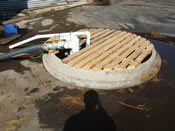
Sump
Wastewater containing organic matter can remain in valve boxes long enough to ferment. Fermented liquids can also leak from pumps, valves, or pipes into the valve box. Gases produced by these liquids are toxic and can quickly cause death when inhaled at high concentrations.
To reduce the risk, choose (or retrofit) equipment so workers don't have to enter the space to complete repairs or maintenance. For example, use pump, valve, or motor-lifting devices.
| Hazards | Hazardous work |
|
|
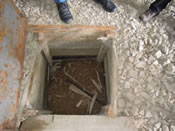
Valve box
Mushroom farm composting operations may have many types and shapes of water tanks or cisterns (a cistern is a waterproof structure used for storing rainwater). These may include horizontal or vertical tanks with hatches at the top. Interior tanks have very little clearance between the top hatch and the roof of the tank room. Outdoor water cisterns are often open at the top.
Normally, hazardous gases will not be present in a water tank or cistern, as long as the water is clean. However, some common cleaning and disinfecting chemicals can produce very toxic gases, even in small amounts. Low-oxygen conditions can also occur if the tank has been empty for a while. If organic matter settles to the bottom of an open outdoor cistern it can ferment and produce gases that are highly toxic. These gases can quickly cause death when inhaled at high concentrations. The gases can be released if the sediment at the bottom of the cistern is disturbed. This can happen by workers walking on the sediment when the cistern is empty.
With water tanks and cisterns, the greatest risk is from drowning, which can occur in as little as 15 cm of water.
There's also a risk of injury or death if mechanical equipment is not properly locked out.
| Hazards | Hazardous work |
|
|
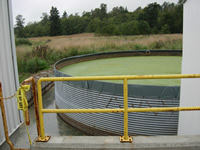 |
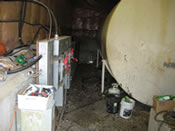 |
| Water cistern | Water tank inside a shed |
A well pit is the chamber at the top of a wellhead. If the chamber is located under the floor of a building it is considered a confined space. The well pit provides access to the well and pumping equipment. It also prevents freeze-up in the pressure tank and piping.
Normally, hazardous gases won't be present in a well provided there's very little (or no) organic material in the water. However, depending on the layout of the well, oxygen may be depleted. For example, if metal bracing rusts it will deplete the oxygen, especially if the well is closed at the top.
| Hazards | Hazardous work |
|
|
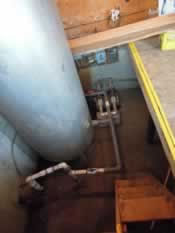 |
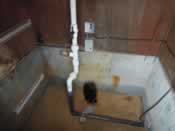 |
| Well pits |
Highlights
- New risk advisory on the dangers of fire and explosion in asphalt mix plants Published on: August 15, 2023
- New online tool helps workers and employers manage risk by delivering a custom list of health and safety resources Published on: December 05, 2022
- New slide show highlights the importance of protecting workers from the hazards of confined spaces in agriculture Published on: August 29, 2022

